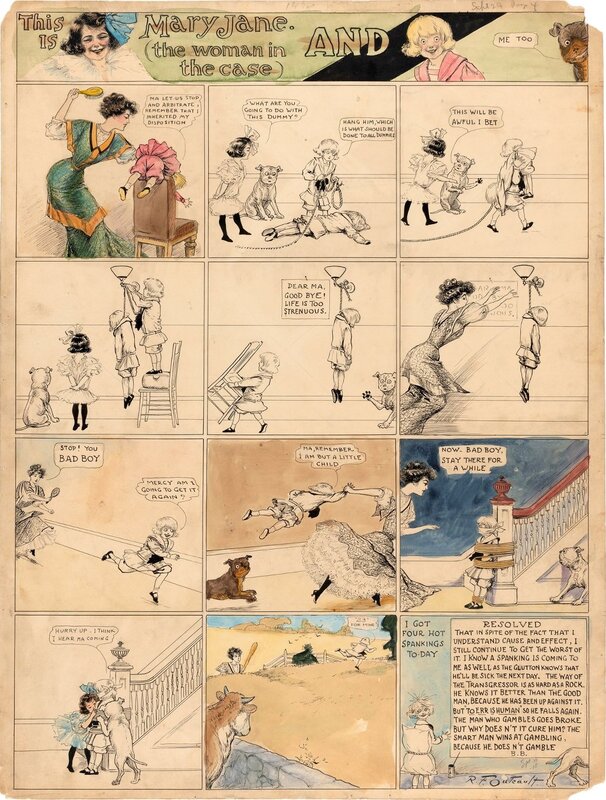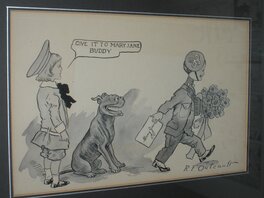In comixfan 's collection
Comment
Fun but morbid Buster Brown with a hanging gag which would never see the light of day if thought up in current times. Buster also catches heck, is spanked and tied up in this one. There is so much wrong here but was in keeping with social norms at the time it was printed.
Buster Brown was a comic strip created by Richard F. Outcault in 1902 and it ran for almost 20 years. It featured a young boy who dressed in Victorian garb and was always getting in trouble for his tricks and mischievousness. There were frequent spankings with hands, brushes and other items. They often ended with a text panel and a bit of lesson. I found many of these panels quite enlightened and insightful for the era in which they were created in.
Until recently, these Sundays were quite scarce and they continue to be rare but the estate has been releasing them for the past few years so they are starting to find their way into more collections. I have only ever seen two of these in person prior to the ones you see here. I have yet to see these too as they are on the way still.
A bit more history
Richard F. Outcault was a pioneer in early comics. Although not the absolute first comic strip he was the first to popularize sequential art and his Yellow Kid feature was a huge financial success prompting newspapers to start to include more comic strips. Yellow Kid began in 1894 and Outcault was frustrated as the marketing and merchandising of his character was very profitable but he saw little of this. In 1902 he created Buster Brown and it was an immediate hit out performing Yellow Kid. By 1904 he was merchandising clothing and toys including the Buster Brown shoes. It is reported that in 1904 he was making $75,000 per year from the merchandising. That is somewhere between $2 and $15 million dollars per year in 2020 dollars depending on how you analyze it. When he took the strip away from the Herald where he created it to a Hearst paper, he sued to get the Herald to stop publishing the strip with different artists. This is considered among the first court case for creator rights like this. He lost in that the Herald was granted the rights to the title Buster Brown but not the character likeness. So, Outcault continued to create the series but stopped using the title. Outcault started his professional career painting advertisements for Edison light bulbs but went on to huge success in newspaper comics. He retired in 1921 and continued to paint for the remaining decade of his life.
Buster Brown was a comic strip created by Richard F. Outcault in 1902 and it ran for almost 20 years. It featured a young boy who dressed in Victorian garb and was always getting in trouble for his tricks and mischievousness. There were frequent spankings with hands, brushes and other items. They often ended with a text panel and a bit of lesson. I found many of these panels quite enlightened and insightful for the era in which they were created in.
Until recently, these Sundays were quite scarce and they continue to be rare but the estate has been releasing them for the past few years so they are starting to find their way into more collections. I have only ever seen two of these in person prior to the ones you see here. I have yet to see these too as they are on the way still.
A bit more history
Richard F. Outcault was a pioneer in early comics. Although not the absolute first comic strip he was the first to popularize sequential art and his Yellow Kid feature was a huge financial success prompting newspapers to start to include more comic strips. Yellow Kid began in 1894 and Outcault was frustrated as the marketing and merchandising of his character was very profitable but he saw little of this. In 1902 he created Buster Brown and it was an immediate hit out performing Yellow Kid. By 1904 he was merchandising clothing and toys including the Buster Brown shoes. It is reported that in 1904 he was making $75,000 per year from the merchandising. That is somewhere between $2 and $15 million dollars per year in 2020 dollars depending on how you analyze it. When he took the strip away from the Herald where he created it to a Hearst paper, he sued to get the Herald to stop publishing the strip with different artists. This is considered among the first court case for creator rights like this. He lost in that the Herald was granted the rights to the title Buster Brown but not the character likeness. So, Outcault continued to create the series but stopped using the title. Outcault started his professional career painting advertisements for Edison light bulbs but went on to huge success in newspaper comics. He retired in 1921 and continued to paint for the remaining decade of his life.
4 comments
To leave a comment on that piece, please log in
About Richard Felton Outcault
Richard Felton Outcault was one of the great comic pioneers, and often credited as the inventor of the comic strip. Coming from Lancaster, Ohio, Outcault was a graduate from the McMicken University in Cincinnati, who studied art in Paris, and eventually settled in New York. After doing illustration work for publications like The Electrical World, Life and Judge, he was hired by media tycoon Joseph Pulitzer to come and work for the New York World in 1894.
For this newspaper, Outcault made series of often crowded cartoons set in certain quarters in Manhattan, which eventually resulted in the feature 'Down in Hogan's Alley'. Being one of the first continuing series with a regular cast, one character stood out. At the time, it was still difficult to use yellow ink in color printing, since it didn't dry properly. When one of the World's foremen of the color-press room wanted to experiment with a new type of yellow ink, he used the shirt of one of Outcault's characters as a test area. 'The Yellow Kid' was born.
Text (c) Lambiek


